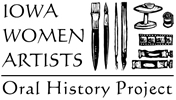PRISCILLA STEELE
artwork
audio 
(see also Making Art in Iowa and Art & Spirituality)
- Early art (60 sec. | 410KB): listen | read
- College (54 sec. | 370KB): listen | read
- Design team (59 sec. | 403KB): listen | read
- Artwork (61 sec. | 419KB): listen | read
- Personal life (55 sec. | 377KB): listen | read
- The figure (59 sec. | 407KB): listen | read
audio text
Early art
My grandfather when he retired, had always wanted to paint, and set up his studio in their front bedroom in a little Philadelphia suburb. And I would alternate my time in the summers between my grandparents on Long Island and these grandparents in Philadelphia. And I would paint with him. I just loved it—you know, we could paint for hours. And the nice thing about that period of time was that it was totally unself-conscious. My father also drew a lot, and he introduced me to pen and ink, which is where my interest in and, I think, my facility with line came from. Itís interesting that those came from my father and my motherís father, because there was no goal in mind other than their own enjoyment. Iíve gotten this strong goal-oriented ethic from my mother, and then this sort of meandering, B-type personality from the men in my family.
College
I had a wonderful instructor at St. Lawrence University, where I did my undergrad work, who really proved very important—his name was Roger Bailey. He was a really important influence as far as his own sensibility and approach to art; he encouraged sort of personal discovery, which I needed at that point. But part of personal discovery was absolute confusion about, well, I do have an innate ability to draw, but of what importance is that if I donít have anything to say? So thatís when being goal-oriented and that simple love of doing something sort of collided in a very painful way. But I did get a great education. I was able to study in Spain for a year, and that was a real pivotal experience in my growing up. I saw art firsthand, and that was extremely meaningful.
Design team
My husband and I met in VISTA. And the plan was that he would broker his skills as a set designer, and I would paint the sets while I pursued my printmaking. In three years, we moved thirteen times, lived in Midwestern cities from as small as Mount Carroll, Illinois, to Ann Arbor, Michigan. And it was exciting, because every time, you walked in and you created order out of chaos. And steadily, I found myself gaining great confidence. I was no longer confused. I realized that my drawing ability really, practically, served me well, because what Craig could imagine in three dimensions and in a plan view, I could pull up in gorgeous renderings, and we became this dynamite team. And we made a living in art, which was nothing short of amazing. It wasnít much of a living, but we did it.
Artwork
The work has continued to be figurative. The great frustration with printmaking is that itís an indirect process. And so, what I started doing was taking plates already prepared into life-drawing situations and just drawing right on those plates, and then it was just like my own drawing process. If a mark worked, great, Iíd keep it; if it didnít work, I could burnish that out with asphaltum or I could etch it for a little bit and then cover it with asphaltum. So the work was very dependent on the use of a spontaneous, emotional, expressive gesture that was activated by the drawing marks that led up to a final gesture that was oftentimes refined in the linear quality of my drawing. It does start with a classically conceived figure, and a naturally observed figure in a life drawing studio. But itís very much abstracted along the way by incorporating multiple poses and all the drawing marks.
Personal life
I guess that I canít talk about my work without talking about my personal life because the two are importantly linked, basically linked. Itís very difficult to allow somebody the freedom that they need to do something that doesnít have any immediate promise of financial remuneration. Thatís tough. And you can spend a lot of time in your studio doing something that you do wash away completely at the end of the day. The challenges that Iíve had to take in my relationship with Craig to the work that I do, and the time that it does take away from our family life, and the sacrifices that our children have made for both Craigís and my life in doing what we do—because both of us are artists—the sacrifices have been extreme. But I think that on balance, our kids have had a good life.
The figure
Sometimes you go to the altar, you do all the work, but you come back with nothing. And other times, thereís so little work involved but it just goes right. But the ongoing going to the studio is really important. As far as what I enjoy, I always enjoy a life drawing situation, and I think that itís because I have just always found the figure as a logical vehicle for human expression, and I can, particularly with the female figure, put myself right in that.
There arenít a lot of people who work with the figure successfully in a meaningful and spiritual way, here. And I think I do. So I am aware of the fact that I do gain a lot of admiration in that regard. And there are some people who just donít care about my work at all. Kind of theyíre scared of it, because the figure sometimes is nude, and if that bothers them, I really donít have any control over that at all.





